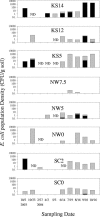Presence and growth of naturalized Escherichia coli in temperate soils from Lake Superior watersheds
- PMID: 16391098
- PMCID: PMC1352292
- DOI: 10.1128/AEM.72.1.612-621.2006
Presence and growth of naturalized Escherichia coli in temperate soils from Lake Superior watersheds
Abstract
The presence of Escherichia coli in water is used as an indicator of fecal contamination, but recent reports indicate that soil populations can also be detected in tropical, subtropical, and some temperate environments. In this study, we report that viable E. coli populations were repeatedly isolated from northern temperate soils in three Lake Superior watersheds from October 2003 to October 2004. Seasonal variation in the population density of soilborne E. coli was observed; the greatest cell densities, up to 3 x 10(3) CFU/g soil, were found in the summer to fall (June to October), and the lowest numbers, < or =1 CFU/g soil, occurred during the winter to spring months (February to May). Horizontal, fluorophore-enhanced repetitive extragenic palindromic PCR (HFERP) DNA fingerprint analyses indicated that identical soilborne E. coli genotypes, those with > or =92% similarity values, overwintered in frozen soil and were present over time. Soilborne E. coli strains had HFERP DNA fingerprints that were unique to specific soils and locations, suggesting that these E. coli strains became naturalized, autochthonous members of the soil microbial community. In laboratory studies, naturalized E. coli strains had the ability to grow and replicate to high cell densities, up to 4.2 x 10(5) CFU/g soil, in nonsterile soils when incubated at 30 or 37 degrees C and survived longer than 1 month when soil temperatures were < or =25 degrees C. To our knowledge, this is the first report of the growth of naturalized E. coli in nonsterile, nonamended soils. The presence of significant populations of naturalized populations of E. coli in temperate soils may confound the use of this bacterium as an indicator of fecal contamination.
Figures






Similar articles
-
The population structure of Escherichia coli isolated from subtropical and temperate soils.Sci Total Environ. 2012 Feb 15;417-418:273-9. doi: 10.1016/j.scitotenv.2011.12.041. Epub 2012 Jan 20. Sci Total Environ. 2012. PMID: 22264918
-
Factors controlling long-term survival and growth of naturalized Escherichia coli populations in temperate field soils.Microbes Environ. 2010;25(1):8-14. doi: 10.1264/jsme2.me09172. Microbes Environ. 2010. PMID: 21576846
-
Geographic isolation of Escherichia coli genotypes in sediments and water of the Seven Mile Creek - A constructed riverine watershed.Sci Total Environ. 2015 Dec 15;538:78-85. doi: 10.1016/j.scitotenv.2015.08.013. Epub 2015 Aug 22. Sci Total Environ. 2015. PMID: 26298250
-
Presence and sources of fecal coliform bacteria in epilithic periphyton communities of Lake Superior.Appl Environ Microbiol. 2007 Jun;73(12):3771-8. doi: 10.1128/AEM.02654-06. Epub 2007 Apr 27. Appl Environ Microbiol. 2007. PMID: 17468280 Free PMC article.
-
Environmental Escherichia coli: ecology and public health implications-a review.J Appl Microbiol. 2017 Sep;123(3):570-581. doi: 10.1111/jam.13468. Epub 2017 Jul 3. J Appl Microbiol. 2017. PMID: 28383815 Review.
Cited by
-
The General Stress Response Is Conserved in Long-Term Soil-Persistent Strains of Escherichia coli.Appl Environ Microbiol. 2016 Jul 15;82(15):4628-4640. doi: 10.1128/AEM.01175-16. Print 2016 Aug 1. Appl Environ Microbiol. 2016. PMID: 27235429 Free PMC article.
-
Toolbox Approaches Using Molecular Markers and 16S rRNA Gene Amplicon Data Sets for Identification of Fecal Pollution in Surface Water.Appl Environ Microbiol. 2015 Oct;81(20):7067-77. doi: 10.1128/AEM.02032-15. Epub 2015 Jul 31. Appl Environ Microbiol. 2015. PMID: 26231650 Free PMC article.
-
Relationship between Desiccation Tolerance and Biofilm Formation in Shiga Toxin-Producing Escherichia coli.Microorganisms. 2024 Jan 24;12(2):243. doi: 10.3390/microorganisms12020243. Microorganisms. 2024. PMID: 38399647 Free PMC article.
-
Human fecal and pathogen exposure pathways in rural Indian villages and the effect of increased latrine coverage.Water Res. 2016 Sep 1;100:232-244. doi: 10.1016/j.watres.2016.05.015. Epub 2016 May 4. Water Res. 2016. PMID: 27192358 Free PMC article. Clinical Trial.
-
Long-term persistence and leaching of Escherichia coli in temperate maritime soils.Appl Environ Microbiol. 2010 Mar;76(5):1449-55. doi: 10.1128/AEM.02335-09. Epub 2009 Dec 28. Appl Environ Microbiol. 2010. PMID: 20038692 Free PMC article.
References
-
- Berry, C., B. J. Lloyd, and J. S. Colbourne. 1991. Effect of heat shock on recovery of Escherichia coli from drinking water. Water Sci. Technol. 24:85-88.
-
- Berry, E. D., and D. N. Miller. 2005. Cattle feedlot soil moisture and manure content: II. Impact on Escherichia coli O157. J. Environ. Qual. 34:656-663. - PubMed
Publication types
MeSH terms
Substances
LinkOut - more resources
Full Text Sources
Other Literature Sources

